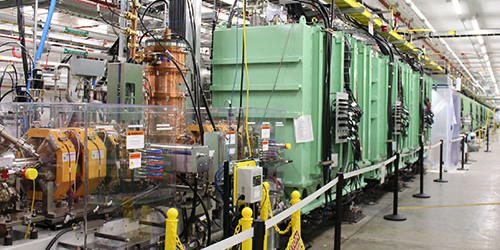A Liquid Method to Prepare Ion Beams
This month, experiments started at Michigan State University’s Facility for Rare Isotope Beams (FRIB). FRIB has an accelerator that propels atoms at half the speed of light, smashing them on a target that produces rare isotopes (see Research News: Rare Isotopes for the Choosing). To enable such a machine to effectively deliver high-power ion beams, a section of the pipe guiding the beam is intersected by a solid film that removes electrons from the ion beam. This removal increases the beam’s charge state, improving its acceleration efficiency. The charge-stripping material, however, can be degraded by the ion beams. Now, Takuji Kanemura and his colleagues at FRIB report on the success of an alternative charge-stripping method being used at FRIB, which they say overcomes the limitations of other charge-stripping techniques [1].
The new method uses a thin-film jet of liquid lithium to strip the beam’s charge. The initial 0.5-mm-diameter jet is spread out into a 10–20-𝜇m-thick, 1-cm-wide film that flows directly across the path of the ion beam at a speed of 50 m/s. After the FRIB’s 20-MeV-per-nucleon uranium ion beam strikes the jet, the beam’s average charge state doubles to 73.7, the value needed for optimal acceleration. The jet remains hydrodynamically stable.
In tests, Kanemura and his colleagues show that their charge-stripping jet can match the performance of a traditional solid charge stripper, which has a charge state of up to 76.9. The jet also undergoes no degradation, increasing the charge stripper’s lifetime indefinitely.
–Rachel Berkowitz
Rachel Berkowitz is a Corresponding Editor for Physics Magazine based in Vancouver, Canada.
References
- T. Kanemura et al., “Experimental demonstration of the thin-film liquid-metal jet as a charge stripper,” Phys. Rev. Lett. 128, 212301 (2022).




